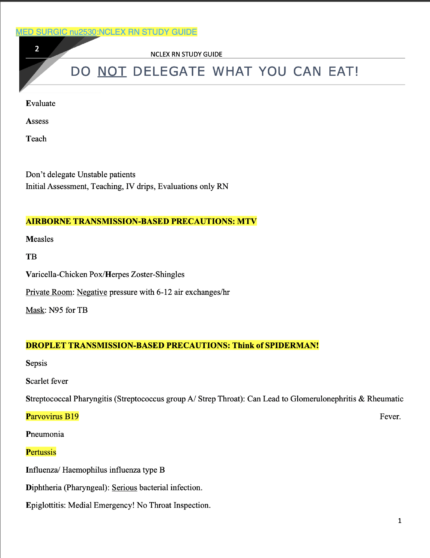NCLEX RN Exam Test Bank With Rationale – ( 500 Q & A) Well Explained And Correct
NCLEX-RN Exam TEST BANK with RATIONALE
1001
Which electrolyte abnormalities would the nurse expect to occur while working with a client who just sustained partial- and full-thickness burns?
1) Decreased sodium and increased potassium 2) Increased calcium and decreased potassium 3) Decreased magnesium and increased sodium 4) Increased sodium and decreased potassium
CORRECT ANSWER: 1
RATIONALE: Sodium levels decrease and potassium levels increase secondary to massive fluid shifts into the interstitium and the release of potassium from cells that are destroyed. The other responses are incorrect.
COGNITIVE LEVEL: Application
CLIENT NEED: Physiological Integrity: Physiological Adaptation
INTEGRATED PROCESS: Nursing Process: Analysis
CONTENT AREA: Adult Health: Integumentary
STRATEGY: Associate high potassium levels with cell destruction and make sure both items
in the option are correct.
1002
The nurse provides teaching to a client after the removal of a short leg cast. The nurse should include which of the following in discussions with the client?
1) Wash the skin with undiluted hydrogen peroxide. 2) Vigorously scrub the legs to remove dead skin. 3) Gently wash and lubricate the leg.
4) Avoid touching the leg for 2 weeks.
CORRECT ANSWER: 3
RATIONALE: Dead skin and exudates often collect under the cast, and efforts to remove it should be done gradually. The client should be instructed to avoid any vigorous scrubbing of the skin to avoid breaks, which increase the risk for infection. The use of undiluted peroxide is too harsh for the skin. There is no reason why the leg cannot be touched after removal of the cast.
COGNITIVE LEVEL: Application
CLIENT NEED: Physiological Integrity: Physiological Adaptation
INTEGRATED PROCESS: Nursing Process: Implementation
CONTENT AREA: Adult Health: Musculoskeletal
STRATEGY: The core issue of the question is the knowledge of skin care following cast
removal. Use nursing knowledge and the process of elimination to make a selection.
1003
Which of the following nursing diagnoses would be the priority for a client with Paget’s disease?
1) Risk for noncompliance
2) Disturbed sleep pattern
3) Impaired physical mobility 4) Disturbed body image
CORRECT ANSWER: 3
RATIONALE: Impaired physical mobility is the appropriate priority nursing diagnosis for a client with Paget’s disease. The client needs to remain active to decrease the complications associated with immobility and to maintain the ability to perform self-care activities. The other diagnoses, although appropriate, are not the priority in clients with Paget’s disease.
COGNITIVE LEVEL: Application
CLIENT NEED: Physiological Integrity: Physiological Adaptation
INTEGRATED PROCESS: Nursing Process: Planning
CONTENT AREA: Adult Health: Musculoskeletal
STRATEGY: The core issue of the question is the knowledge of priorities for the client with
Paget’s disease. Use nursing knowledge and the process of elimination to make a selection.
1004
A client with a right arm cast for fractured humerus states, “I haven’t been able to extend the fingers on my right hand since this morning.” What action should the nurse take next?
1) Assess neurovascular status.
2) Ask the client to massage the fingers.
3) Encourage the client to take the prescribed analgesics as ordered. 4) Elevate the right arm on a pillow to reduce edema.
CORRECT ANSWER: 1
RATIONALE: This symptom suggests neurological injury caused by pressure on nerves and soft tissue because of swelling. Other symptoms of neurovascular compromise should be assessed and reported to the physician.
COGNITIVE LEVEL: Analysis
CLIENT NEED: Physiological Integrity: Physiological Adaptation INTEGRATED PROCESS: Nursing Process: Implementation
CONTENT AREA: Adult Health: Musculoskeletal
STRATEGY: The core issue of the question is the knowledge of priority assessments in a client with possible compartment syndrome. Use nursing knowledge and the process of elimination to make a selection.
1005
A client with an open fracture is at risk for developing osteomyelitis. Which of the following classic symptoms would the nurse assess for to detect the development of this complication?
1) Low bone density
2) Elevated temperature
3) Acute respiratory distress
4) Shortening of the affected extremity
CORRECT ANSWER: 2
RATIONALE: Elevated temperature is a classic symptom seen with this osteomyelitis as a systemic response to the invading organism. Pain, swelling, and tenderness may also accompany the fever. Acute respiratory distress (option 3) is more suggestive of embolism but not the infection. The extremity does not shorten.
COGNITIVE LEVEL: Application
CLIENT NEED: Physiological Integrity: Physiological Adaptation INTEGRATED PROCESS: Nursing Process: Assessment
CONTENT AREA: Adult Health: Musculoskeletal
STRATEGY: The core issue of the question is the knowledge of manifestations of
osteomyelitis. Use nursing knowledge and the process of elimination to make a selection.
1006
An obese client with degenerative joint disease is being managed pharmacologically with aspirin therapy. The nurse knows that additional client teaching is necessary when the client makes which of the following statements?










